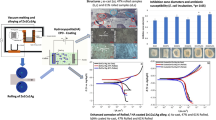Abstract
The current work examines the effect of compaction loading rate on mechanical and tribological behavior of Mg-TiO2 functionally graded material produced by powder-metallurgy. Using a blender designed and manufactured in this work, magnesium (Mg) and titanium oxide (TiO2) powders were mixed and graded using a linear function. The Mg/TiO2 mixtures were then hot compacted at various loading rates utilizing a universal testing device Instron, drop hammer and Split Hopkinson bar. The tribological behavior of the samples was examined through SEM analysis and wear tests and the mechanical properties, such as hardness, compressive strength and indentation resistance were measured using compression, indentation, and hardness tests. The results suggest that the compaction loading rate has significant effect on tribological and mechanical behaviour of the specimens. In general, the increase in loading rate improves the mechanical properties such as hardness, indentation resistance and ultimate strength and tribological parameters such as wear rate and friction coefficient.












Similar content being viewed by others
Change history
15 November 2023
A Correction to this paper has been published: https://doi.org/10.1007/s12666-023-03150-6
References
Watanabe Y, Sato R, Kim I-S, Miura S, and Miura H, Mater. Trans. 46 (2005) 944.
Watanabe Y, and Sato H, Nanocompos Unique Prop Appl Med Ind 133 (2011) 150.
Tsukamoto H, Komiya Y, Oshima N, Sato H, and Watanabe Y, Appl Mech Mater Trans Tech Publ 421 (2013) 272.
Gasik M, Kawasaki A, and Ueda S, Mater Dev Process Bulk Amorph Mater Undercool Powder Metall 8 (2000) 258.
Kawasaki A, and Watanabe R, Ceram Int 23 (1997) 73.
Watari F, Yokoyama A, Saso F, Uo M, and Kawasaki T, Compos Part B Eng 28 (1997) 5.
Mahamood R M, Akinlabi E T, Shukla M, and Pityana S L, Functionally graded material: an overview (2012).
Nemat-Alla M M, Ata M H, Bayoumi M R, and Khair-Eldeen W, Mater Sci Appl 2 (2011) 1708.
Roy S, Mater Today Chem 18 (2020) 100375.
Canakci A, Varol T, Özkaya S, and Erdemir F, Univ J Mater Sci 2 (2014) 90.
Watari F, Yokoyama A, Omori M, Hirai T, Kondo H, Uo M, and Kawasaki T, Compos Sci Technol 64 (2004) 893.
Chu C, Xue X, Zhu J, and Yin Z, Mater Sci Eng A 429 (2006) 18.
Takahashi H, Watari F, Nishimura F, and Nakamura H, J Jpn Soc Dent Mater Devices 11 (1992) 462.
Inaguma Y, Sato H, and Watanabe Y, Mater Sci Forum Trans Tech Publ (2010) 441.
A. S. F. Testing, Materials, ASTM E384: Standard Test Method for Microindentation Hardness of Materials, ASTM West Conshohocken (2017).
A. Standard, G99–05, Standard Test Method for Wear Testing with a Pin-on-Disk Apparatus, ASTM International, West Conshohocken, PA (2005).
Yi M-J, Yin H-q, Wang J-z, Yuan X-j, and Qu X-h, Front Mater Sci China 3 (2009) 447.
Faruqui A N, Manikandan P, Sato T, Mitsuno Y, and Hokamoto K, Metals Mater Int 18 (2012) 157.
Rahmani K, Majzoobi G, Ebrahim-Zadeh G, and Kashfi M, Trans Nonferrous Metals Soc China 31 (2021) 371.
Majzoobi G, Mohammadi M, and Rahmani K, J Mech Behav Biomed Mater 136 (2022) 105497.
Sadooghi A, and Rahmani K, J Mech Sci Technol 35 (2021) 1121.
Sadooghi A, Rahmani K, and Hashemi S, Strength Mater (2022) 1–15.
Markov D, and Kelly D, Wear 239 (2000) 189.
Archard J, J Appl Phys 24 (1953) 981.
Jafari M, Enayati M, Abbasi M, and Karimzadeh F, Mater Des 31 (2010) 663.
Anvari S, Karimzadeh F, and Enayati M, J Alloys Compd 562 (2013) 48.
Majzoobi G, Rahmani K, Mohamadi M, Bakhtiari H, and Das R, Biotribology (2022) 100233.
Jafari M, Abbasi M, Enayati M, and Karimzadeh F, Adv Powder Technol 23 (2012) 205.
Dubey A, Jaiswal S, Haldar S, Roy P, and Lahiri D, Biomed Mater 16 (2020) 015017.
Stalin B, Vidhya V, Ravichandran M, Kumar A N, and Sudha G, Noveishie Tekhnol 42 (2020) 497.
Radhakrishnan G, Anirudh P, and Kumar S A, Mechanical Behavior of Nanoparticulate TiO2 Reinforced Magnesium Matrix Composite, IOP Conference Series: Materials Science and Engineering, IOP Publishing (2019) p 012006.
Rahmani K, Sadooghi A, and Hashemi S J, Mater Res Express 7 (2020) 085012.
Rahmani K, Majzoobi G, and Bakhtiari H, Mater Chem Phys 271 (2021) 124946.
Rahmani K, Nouri A, Wheatley G, Malekmohammadi H, Bakhtiari H, and Yazdi V, J Mater Res Technol 14 (2021) 2107.
Rahmani K, Sadooghi A, and Nokhberoosta M, J Mater Res Technol 9 (2020) 1104.
Rahmani K, and Majzoobi G-H, Modares Mech Eng 18 (2018) 361.
Majzoobi G, Rahmani K, and Kashfi M, J Stress Anal 4 (2020) 19.
Acknowledgements
The authors of this work truly thank Iran National Science Foundation (INSF), Project Title: “Fabrication and physical and mechanical characterization of Functionally Graded Materials (FGM's) produced by Dynamic Compaction Method by Split Hopkinson Bar” (Code number: 97017026), for their financial support without which the work was not possible to be accomplished.
Author information
Authors and Affiliations
Corresponding author
Ethics declarations
Conflict of interest
The authors declare that they have no conflict of interest.
Additional information
Publisher's Note
Springer Nature remains neutral with regard to jurisdictional claims in published maps and institutional affiliations.
The original online version of this article was revised. In this article the author’s name Gholamhossein Majzoobi was incorrectly written as Gholamhossein MajSzoobi.
Rights and permissions
Springer Nature or its licensor (e.g. a society or other partner) holds exclusive rights to this article under a publishing agreement with the author(s) or other rightsholder(s); author self-archiving of the accepted manuscript version of this article is solely governed by the terms of such publishing agreement and applicable law.
About this article
Cite this article
Rahmani, K., Majzoobi, G. A Study of the Functionally Graded (Magnesium/Titanium Dioxide) Material's Mechanical and Tribological Characteristics Fabricated at Various Compaction Loading Rates. Trans Indian Inst Met 76, 3175–3185 (2023). https://doi.org/10.1007/s12666-023-03072-3
Received:
Accepted:
Published:
Issue Date:
DOI: https://doi.org/10.1007/s12666-023-03072-3




